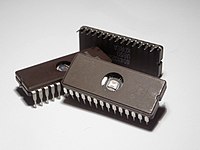
Photo from wikipedia
In the last decade, silicon photonic switches are increasingly believed to be potential candidates for replacing the electrical switches in the applications of telecommunication networks, data center and high-throughput computing,… Click to show full abstract
In the last decade, silicon photonic switches are increasingly believed to be potential candidates for replacing the electrical switches in the applications of telecommunication networks, data center and high-throughput computing, due to their low power consumption (Picojoules per bit), large bandwidth (Terabits per second) and high-level integration (Square millimeters per port). This review paper focuses on the state of the art and our perspectives on silicon photonic switching technologies. It starts with a review of three types of fundamental switch engines, i.e., Mach-Zehnder interferometer, micro-ring resonator and micro-electro-mechanical-system actuated waveguide coupler. The working mechanisms are introduced and the key specifications such as insertion loss, crosstalk, switching time, footprint and power consumption are evaluated. Then it is followed by the discussion on the prototype of large-scale silicon photonic fabrics, which are based on the configuration of above-mentioned switch engines. In addition, the key technologies, such as topological architecture, passive components and optoelectronic packaging, to improve the overall performance are summarized. Finally, the critical challenges that might hamper the silicon photonic switching technologies transferring from proof-of-concept in lab to commercialization are also discussed.
Journal Title: Micromachines
Year Published: 2019
Link to full text (if available)
Share on Social Media: Sign Up to like & get
recommendations!